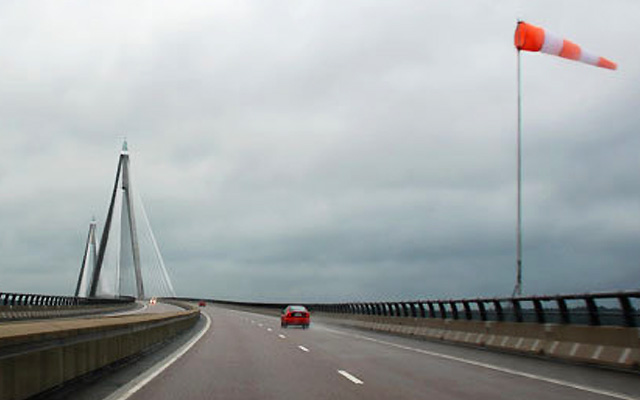Gusts are more likely on open stretches of road, when crossing bridges or gaps in hedges, or when overtaking high-sided vehicles. Strong winds can also bring down trees and branches, blow you off course or blow other vehicles into your path.

Our expert tips for driving in wind
- Keep both hands on the wheel
- Be ready for stronger winds and gusts
- Wind is worse on exposed stretches of road or when passing high-sided vehicles
- Sudden gusts of wind are likely when passing tall buildings in urban areas
- Keep your speed down –when travelling fast, strong gusts will blow you further off course
- Take care and leave extra room around cyclists and motorcyclists. They're particularly vulnerable to sudden gusts and may veer across the road
- Avoid overtaking. Overtaking can be dangerous in strong winds, as there may be a sudden gust as you pass a large vehicle (which could cause it to veer into you)
- Keep your distance from other vehicles, especially high-sided vehicles and caravans
- Avoid towing. High-sided trailers like caravans or horseboxes can be dangerous to tow in windy conditions
- Leave the roof box at home. A roof box can increase the impact of crosswinds on your vehicle
- Look out for debris in the road. Twigs or small branches in the road could mean there's a tree or large branch in the way around the next bend
- Look out for hanging trees. Partially fallen trees can hang above the sweep of your headlights, making them hard to spot
- Plan ahead. Plan your journey carefully, checking weather and traffic bulletins regularly. Ensure you have enough fuel/electrical charge in case of delays or diversions
- Expect lower speed limits or temporary closures
- Exposed bridges may have lower speed limits – especially for towing vehicles
- There could also be road closures due to fallen debris or accidents
- Keep to main roads. Try to drive on main roads if you can, as minor roads are likely to be obstructed by fallen branches and debris
- Park safely. Try not to park near/under trees, telephone wires or poles that could fall onto your car
- If you have a garage you may want to park your vehicle in it to minimise potential damage from strong wind
When is it too windy to drive a car?
Driving conditions can be potentially hazardous when wind reaches speeds of 30-45 mph. When the wind speed goes above 45 mph it will definitely be more dangerous to drive – we recommend avoiding driving if you can.
The UK’s official weather service, The Met Office, issues warnings when bad weather is expected. Listen to local traffic news bulletins to find out what to expect from the weather. Weather warnings are colour-coded according to severity:
Yellow: there will be minimal disruption to your journey
Amber: there will likely be road closures and travel delays
Red: there will be disruptions to your journey due to dangerous weather conditions – you should ideally stay home and avoid travelling if possible
Which vehicles are least affected by side winds?
Vehicles with a low centre of gravity, like a saloon car or an SUV with a low ground clearance, would be the least affected by side winds (along with vehicles that have a wider wheelbase and weigh in heavier). However, no vehicle is completely immune to side winds, so you should always take extra care no matter which type of vehicle you're driving.
Should extra caution be taken when overtaking in windy weather?
Yes, overtaking in windy weather is much riskier than usual, so only do it if it's absolutely safe (and unavoidable). You should give more vulnerable road users (like cyclists and motorcyclists) additional space because strong winds are more likely to make them veer from side to side.
What to do if you break down
If you break down during a storm, make sure you put your hazard lights on to make you more visible to other motorists.
Contact the emergency services or your breakdown service and stay in your vehicle, unless there’s somewhere safer to wait. Make sure you're covered in these situations by buying breakdown cover with us.
We provide 24/7 roadside assistance.
Why choose us?
- UK drivers have consistently rated us as the best breakdown service against all other major breakdown providers.
- Our patrols will usually get to you in less than an hour and get you back on the road within around 30 minutes of arrival.
Verify at theAA.com/Best
Last updated: 30 May 2024 Author: The AA
